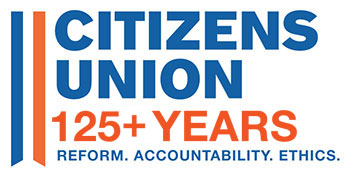Originally Published: January 23, 2013
Number of seats held far apart from voters party registration or total number of votes cast
Twelve senate Democrats told their voters in Summer 2012 they will support constitutional amendment on redistricting
Citizens Union, an independent nonpartisan good government watchdog, released this morning an analysis of election results in New York State, finding that majority parties in each house were able to solidify or strengthen their holds on the house they controlled after each election. Parties in control of drawing the lines – Republicans in the state senate and Democrats in the state assembly – created safe seats where elected officials ran in districts that were often uncontested or with very little opposition from the other party. Citizens Union’s report found that a third of all seats were unopposed by the other major party in the 2012 General Election.
Citizens Union also released the names of the twelve Democratic state senators who during the 2012 campaign publicly committed to vote in favor of the constitutional redistricting amendment — the very same amendment that passed the state legislature last year. They expressed their support in response to a question on the Citizens Union candidate questionnaire, in face to face interviews, or in candidate debates held before their constituents. These twelve senators are Joseph Addabbo, Eric Adams, Tony Avella, Martin Dilan, Adriano Espaillat, Brad Hoylman, Jeffrey Klein, Gustavo Rivera, James Sanders, Diane Savino, Jose Serrano, and David Valesky.
The report had the following major findings:
- The partisan breakdown in each house has largely resulted in a split legislature, with majorities in each house controlled by the two different major political parties, indicating the role of partisan gerrymandering in preserving their respective majority in each house. The state senate has had Republican leadership for all but two years since 1966 (though it should be noted that the current Republican leadership in the senate is due to a power-sharing agreement with the Independent Democratic Caucus) while the state assembly has been controlled by the Democrats since 1975. Since 1980, Democrats have held over 60 percent of the assembly’s seats with many years being over 65 percent, and Republicans have consistently held the balance with about a third of seats in the assembly.
- The share of seats for each party versus share of statewide votes does not line up with number of seats won, showing how partisan gerrymandering has created safe seats for the majorities in each house. Democrats won a disproportionate percentage of seats in the Democratic-controlled assembly in relation to total votes cast in the 2012 General Elections, while Republicans won a disproportionate percentage of seats in the Republican-controlled senate. For example, Democrats won 9 more seats than were proportionally won overall (107 instead of 98), allowing them to remain in control of the assembly. In the senate, Republicans won two more seats than their portion of the overall vote total (30 seats instead of 28).
- The number of uncontested seats in general elections (including no major party challenger) is typically higher for the majority in each house, particularly for the assembly and following redistricting cycles. The number of uncontested Republicans in the state senate dropped from 19 in 2002 to a low of 3 in 2010, and then increased again to 9 in 2012 after redistricting. Democrats in the assembly, meanwhile, have been uncontested in an average of 35 seats over the last decade, to the Republicans’ 13 races.
“In the interest of creating a fair and more balanced redistricting process, Citizens Union calls upon all members of the state senate to pass this constitutional amendment, in particular those twelve Democratic senators who committed their support through our candidate questionnaires in their 2012 races for re-election,” said Dick Dadey, executive director of Citizens Union. “Giving second passage to the constitutional amendment to reform redistricting and create a non-legislative commission would be a critical step in significantly diminishing the power of drawing lines from the hands of legislators. The creation of such a future redistricting commission would ensure that issues important to New Yorkers would be addressed by a process that forces compromise and consensus in the drawing of district lines as opposed to the partisan politics that have overwhelmed the past forty years of drawing these lines and have often produced gridlock and a polarized state legislature.”
“Our report finds that creation of gerrymandered districts by the parties in control means that elected officials have little incentive to reach out beyond their party to find consensus,” said Rachael Fauss, Citizens Union research and policy manager. “Citizens Union’s report shows that for too long, the current redistricting scheme has given the majority parties in each house the ability to draw districts that ignore neighborhoods and communities of interest and instead create districts that solidify or strengthen the parties’ power.”
